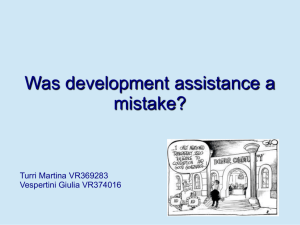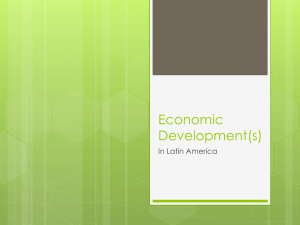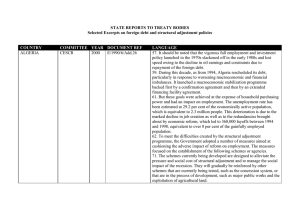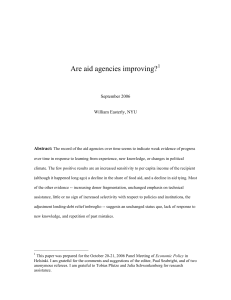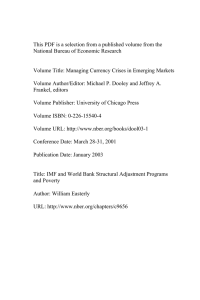How to Keep the Third World Countries at bay Presentation by
advertisement
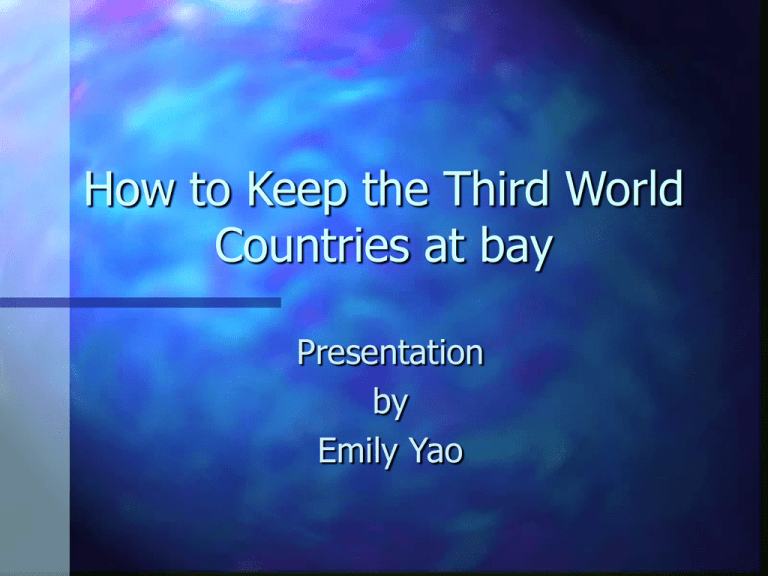
How to Keep the Third World Countries at bay Presentation by Emily Yao Recipients of Aid Single commodity countries – prices fluctuates because of the world market economy Lack of trained people – building an educational system takes time – insufficient amount of people to learn the technology Recipients of Aid Quest for capital – seek it overseas because of lack of supply Need for foodstuffs – implemented policies to encourage cash crops – food for consumption diminished – need food imports to feed citizens Bilateral Aid Direct aid from one country to another, usually from First World countries to Third World countries Multilateral Aid Aid that is funneled by a non-affiliated agency, such as the World Bank or UN agencies – considered to be more objective – less politically affiliated and more freedom is granted to the developing country – less intrusion World Bank History – Created to help in reconstruction after WWII – Grant loans for non-profitable construction like roads, schools, and housing projects. – Loan money to less industrious countries for promotion of their economic growth. International Monetary Fund Mission is to supply member states with money to help them to overcome shortterm balance of payment difficulties Money is only made available after the recipients have agreed to policy reforms in their economies-to structural adjustment Membership of the World Bank is conditional upon membership of the IMF Structural Adjustment Programs Grant other more industrialized countries, like the US, access to resources like cheaper labor and foreign investment with lower export tariffs. Structural Adjustment Programs Third World Countries – national removal of subsidies to the poor on basic food stuffs – tax systems are made more repressive – real wage rates are allowed to fall sharply Structural Adjustment Loans Not tied to one specific project Governments had to agree on a drastic program of liberalization for multi-million dollar loans – reduced state’s role in the economy – lowering barriers to imports, removing restrictions on foreign investment – emphasizing production for export rather than for local consumption Privatization and Deregulation Foreign investment is taking over the developing countries Less power and control on the part of the developing state Can raise rates, which make the poor suffer Local governments are given money to let foreign investment take over. Consequences of Aid Economic deprevation – Social expenditures are slashed, like health and education Environmental devastation – Massive deforestation – Near extinction of nearby coastal fish Solutions Abolish these institutions Create a special UN agency to control the World Bank and the IMF Peoples and countries force change on the institutions, by confronting them with evidence of the injustices Cycle of Oppression Funding for Third World Countries – Never get out of debt – Resources will be depleted to pay the debt – Third World countries will get poorer – Industrialized countries will be more rich Strategic implementation of repayment Conclusion – Once offered funds, Third World Countries will never be out of debt – Kept in a cycle of repayment – This binds the less industrialized countries to ask for more funds – The process of granting aid should be slowed down or thrown out Works Cited Arnold, G.(1985). Aid and the Third World: The North/South Divide. London, Great Britain: Robert Royce Limited. Danaher, K. (1994). 50 Years is Enough: The Case Against The World Bank and the International Monetary Fund. Boston, MA: South End Press. Works Cited Hancock, G. (1989). Lords of Poverty: The freewheeling lifestyles, power, prestige and corruption of the multi-billion dollar aid business. London, Great Britain: MacMillan London Limited. Herman, E. S. (1995). Triumph of the Market. Boston, MA: South End Press.


